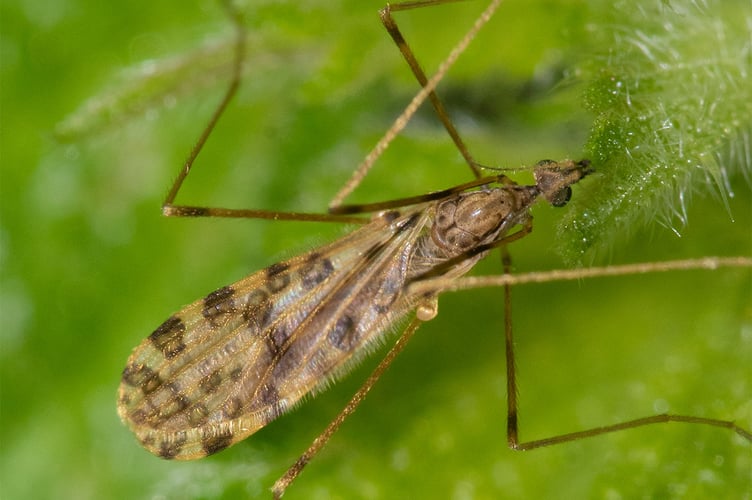For most people craneflies are just those greyish ‘Daddy-long-legs’ flies which are frequently seen during the autumn and will even enter houses. These will probably be Tipula paludosa and the correct common name is Meadow White-stripe. Tipula oleracea (Marsh White-stripe) looks very similar but they are chiefly a spring flying cranefly.
Actually separating those two species is a bit tricky. Tipula oleracea females have longer wings which reach the abdomen tip and both sexes have eyes which are closer together than paludosa when viewed from underneath. However, this isn’t easy to see when encountering a live fly.
The larvae of both Tipula oleracea and paludosa are commonly known as Leatherjackets and can be a pest of grasslands but most other craneflies are harmless.
There are over 350 species of Craneflies in the UK which are sub divided into 6 family groups, ranging from the large Tipula maxima, with a wing span up to 60 mm, to the small craneflies and Winter Gnats with less than 10 mm wing span.

They are a strange looking group which fly with dangling legs and narrow wings which appear under powered. But in most cases, they never fly far from where they emerged so a slow flight isn’t a problem. In a few species the female’s wings are small or absent.
Craneflies have been around in similar forms for millions of years while other flies have undergone substantial changes or have become extinct. So, despite their odd appearance, they are a success story.
In reality, those long legs act as stabilisers in flight and can give a warning of nearby dangers which may help to protect those fragile wings. Legs are easily shed if seized by a predator allowing the fly to escape.

They are important sources of food for birds and other insects, particularly spiders. Some craneflies are night fliers which can be found in moth traps and are taken in considerable numbers by bats.
Adult craneflies have a short life span between 3 and 6 days, or less if they become prey to other animals.
Females have a narrow tapered ovipositor at the tip of their abdomens and are often seen egg laying by pushing their abdomen tips into soft mud when a single egg is released.
While many craneflies are a drab brownish grey colour a few are brightly coloured and can be mimics of some wasp species. Those with a bright yellow thorax and abdomen are generally known as Tiger Craneflies. Most of them are relatively easy to identify from good quality photographs or using a hand lens with a specimen in a collection tube.
Cranefly identification usually begins with a close examination of the wing veins and this will often be sufficient to reach family level. However, getting a full identification to species level frequently requires careful examination with a microscope.

The Orange-tailed Comb-horn Cranefly is an easily recognised brightly coloured species although they are somewhat uncommon and rather localised. Their larvae live in rotten trees, particularly beech.
Wing-band Tiger Craneflies (Nephrotoma quadrifaria) are usually simple to recognise by their colourful markings including a dark line across their wings and a brownish stripe along a pale yellow abdomen. They are widespread and can even be found in gardens.
The Ptychopteridae family are commonly known as Fold-winged Craneflies because they often sit with wings outstretched but slightly twisted. This can make them tricky to fully identify from photographs.
Identifying many of the smaller greyish or brownish craneflies is fraught with problems but a few are reasonably distinctive in appearance. The Ocelot Twist-tail (Ilisia maculata) are under 8 mm in wing length but are fairly easy to recognise and can be found in damp woodland. Cranefly numbers undergo considerable variation from one year to another. These changes are probably due to fluctuations of the weather during their larval stages. Most cranefly species require damp decaying organic matter for successful larval development




